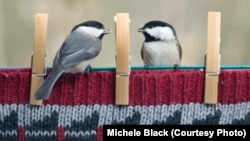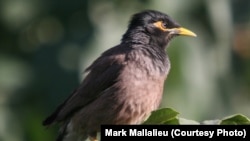Mark Mallalieu has been an avid bird watcher since he was 6 years old. Now he has the opportunity to both follow his passion and do something that counts for his fine-feathered friends.
Between February 14 and 17, Mallalieu will be joining tens of thousands of volunteers from around the world participating in the 17th annual Great Backyard Bird Count.
The four-day count calls on anyone to help collect real-time data on the distribution and numbers of birds throughout the world (see video here).
In Mallalieu's case, that would be Afghanistan, where he currently is the head of the British government's Department for International Development. He says he'll be "in a diplomatic compound in Kabul where there are some trees and I put some food out for the birds, so that's where I'll be.
"A campaign like this to get people looking at their birds in the garden will generate interest in birds, wildlife, conservation, and the environment more generally," he continues. "I think that's the thing that most excites me about [the bird count]."
Tracking Birds' Health Around The World
The Great Backyard Bird Count is a joint project of the Cornell Lab of Ornithology and the National Audubon Society in the United States, along with Bird Studies Canada. The idea is to use "citizen scientists" to conduct bird-related research.
Kathy Dale is the director of Citizen Science at the National Audubon Society. She says scientists will use the data gathered during the upcoming count to investigate changes in birds' habitat and climate, as well as their response to diseases.
"This kind of information that's gathered by tens of thousands of volunteers helps us to track the health of bird populations at a scale that would not otherwise be possible," Dale explains. "For example, in North America the Great Backyard Bird Count has helped us start to learn whether certain species like the American crow will continue to rebound after being hit hard by West Nile virus."
Contributing to the Great Backyard Bird Count is free and simple. Participants pick one or several locations where they will be able to observe birds over at least a 15-minute time period. After setting up an account on the bird-count website, they are then encouraged to tally the number of individual birds of each species they see. A new checklist must be compiled every day, for every location, and in cases where counts are taken at different times of day.
There is even a photography contest for those who wish to submit pictures of birds that they encounter during the event.
Finding Color In The Dead Of Winter
Last year's count shattered records after going global for the first time, with bird watchers reporting their sightings from 111 countries. More than 34.5 million individual birds were counted and nearly one-third of the world's total bird species were identified.
"This is quite wonderful, and we certainly hope to grow all of these numbers, including participation beyond North America," says Dale of the National Audubon Society. "I would invite anyone interested to go on to the Birdcount.org website and look at the list of countries represented last year. It's very, very interesting."
In the inaugural global count, the vast majority of the more than 130,000 checklists were submitted from North America. A total of nine checklists were from Afghanistan, where seven species were recorded. There were four checklists in Kazakhstan and Serbia, three in Montenegro, two in Kyrgyzstan and Russia, and one each in Iraq and Pakistan.
For those who might question the logic of counting birds in places that are in the middle of winter, Mallalieu says that Afghanistan's capital, at least, offers many pleasant surprises.
"Some birds do seem to manage to stick out the very cold winters. There are even parakeets, which you'd think of as a kind of tropical bird. They're bright green with long tails and they're very noisy," says the British official.
"There are lots of little sparrows, called tree sparrows. There are birds called myna birds -- common myna -- which are brown but with very brightly colored yellow patches on their faces. And then there are magpies, doves as well, and, if you're lucky, flying over the city you might see something like a vulture or some other hawk or falcon."
Between February 14 and 17, Mallalieu will be joining tens of thousands of volunteers from around the world participating in the 17th annual Great Backyard Bird Count.
The four-day count calls on anyone to help collect real-time data on the distribution and numbers of birds throughout the world (see video here).
In Mallalieu's case, that would be Afghanistan, where he currently is the head of the British government's Department for International Development. He says he'll be "in a diplomatic compound in Kabul where there are some trees and I put some food out for the birds, so that's where I'll be.
"A campaign like this to get people looking at their birds in the garden will generate interest in birds, wildlife, conservation, and the environment more generally," he continues. "I think that's the thing that most excites me about [the bird count]."
Tracking Birds' Health Around The World
The Great Backyard Bird Count is a joint project of the Cornell Lab of Ornithology and the National Audubon Society in the United States, along with Bird Studies Canada. The idea is to use "citizen scientists" to conduct bird-related research.
Kathy Dale is the director of Citizen Science at the National Audubon Society. She says scientists will use the data gathered during the upcoming count to investigate changes in birds' habitat and climate, as well as their response to diseases.
"This kind of information that's gathered by tens of thousands of volunteers helps us to track the health of bird populations at a scale that would not otherwise be possible," Dale explains. "For example, in North America the Great Backyard Bird Count has helped us start to learn whether certain species like the American crow will continue to rebound after being hit hard by West Nile virus."
Contributing to the Great Backyard Bird Count is free and simple. Participants pick one or several locations where they will be able to observe birds over at least a 15-minute time period. After setting up an account on the bird-count website, they are then encouraged to tally the number of individual birds of each species they see. A new checklist must be compiled every day, for every location, and in cases where counts are taken at different times of day.
There is even a photography contest for those who wish to submit pictures of birds that they encounter during the event.
Finding Color In The Dead Of Winter
Last year's count shattered records after going global for the first time, with bird watchers reporting their sightings from 111 countries. More than 34.5 million individual birds were counted and nearly one-third of the world's total bird species were identified.
"This is quite wonderful, and we certainly hope to grow all of these numbers, including participation beyond North America," says Dale of the National Audubon Society. "I would invite anyone interested to go on to the Birdcount.org website and look at the list of countries represented last year. It's very, very interesting."
In the inaugural global count, the vast majority of the more than 130,000 checklists were submitted from North America. A total of nine checklists were from Afghanistan, where seven species were recorded. There were four checklists in Kazakhstan and Serbia, three in Montenegro, two in Kyrgyzstan and Russia, and one each in Iraq and Pakistan.
For those who might question the logic of counting birds in places that are in the middle of winter, Mallalieu says that Afghanistan's capital, at least, offers many pleasant surprises.
"Some birds do seem to manage to stick out the very cold winters. There are even parakeets, which you'd think of as a kind of tropical bird. They're bright green with long tails and they're very noisy," says the British official.
"There are lots of little sparrows, called tree sparrows. There are birds called myna birds -- common myna -- which are brown but with very brightly colored yellow patches on their faces. And then there are magpies, doves as well, and, if you're lucky, flying over the city you might see something like a vulture or some other hawk or falcon."















